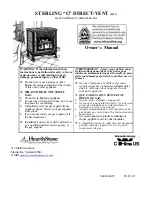
CATALYST MONITORING
It is important to periodically monitor the operation of the catalytic combustor to ensure that it is functioning
properly and to determine when it needs to be replaced. A non-functioning combustor will result in a loss of
heating efficiency, and an increase in creosote and emissions. Following is a list of items that should be
checked on a periodic basis.
Combustors should be visually inspected at least three times during the heating season to determine if physical
degradation has occurred. Actual removal of the combustor is not recommended unless more detailed
inspection is warranted because of decrease in performance. If any of these conditions exist, refer to Catalyst
Troubleshooting Section of the owner’s manual.
This catalytic heater is equipped with the means to install a temperature probe to monitor catalyst operation.
Properly functioning combustors typically maintain temperatures in excess of 1000
o
F. If catalyst
temperatures are not in excess of 500
o
F refer to Catalyst Troubleshooting section of this owner’s manual. You
can get an indication of whether the catalyst is working by comparing the amount of smoke leaving the
chimney when the smoke is going through the combustor and catalyst light-off has been achieved to the
amount of smoke leaving the chimney when the smoke is not routed through the combustor (bypass mode).
Step 1—Light stove in accordance with instructions.
Step 2—With smoke routed through the catalyst, go outside and observe the emissions leaving the
chimney.
Step 3—Engage the bypass mechanism and again observe the emissions leaving the chimney.
Significantly more smoke should be seen when the exhaust is not routed through the combustor (bypass
mode). Be careful not to confuse smoke with steam from wet wood.
CAUTION AGAINST OVER-FIRING
Do Not Over-fire This Heater.
Attempts to achieve heat output rates that exceed heater design specifications can result in permanent damage
to the heater and to the catalytic combustor.
MAINTAIN PROPER DRAFT
Draft is the force which moves air from the appliance up through the chimney. The amount of draft in your
chimney depends on the length of the chimney, local geography, nearby obstructions, and other factors. Too
much draft may cause excessive temperatures in the appliance and may damage the catalytic combustor.
Inadequate draft may cause backpuffing into the room and “plugging” of the chimney or the catalyst.
Inadequate draft will cause the appliance to leak smoke into the room through appliance and chimney
connector joints.
An uncontrollable burn or a glowing red stove part or chimney connector indicates excessive draft.
ASH REMOVAL
Whenever ashes build up in the firebox and when the fire has burned down and cooled, remove excess ashes.
Leave an ash bed approximately 1 inch deep on the firebox bottom to help maintain a hot charcoal bed.
Ashes should be placed in a metal container with a tight fitting lid. The closed container of ashes should be
placed on a non-combustible floor or on the ground, away from all combustible materials, pending final
disposal. The ashes should be retained in the closed container until all cinders have thoroughly cooled.
Summary of Contents for 20 Room Heater
Page 3: ......







































